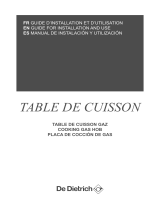
Connection via a flexible metal
hose (stainless steel) with screw
connectors (meeting standard NF D
36-121); the life of such hoses is not
limited.
Connection with a flexible
reinforced rubber hose with
mechanical screw connectors
(meeting standard NF D 36-103) with a
10-year life.
When connecting the gas to your
hob, if you have to change the direction
of the elbow fitted into the appliance:
• Change the seal.
• Tighten the nut on the elbow
ensuring that you do not exceed a
tightening torque of 17 N.m.
• Gas supplied from a cylinder or
tank (butane/propane gas) (1.3.2).
For your safety, you must choose only
one of the following three connections:
Connection via a rigid copper
pipe with mechanical screw
connectors (½" gas standard). Connect
directly to the elbow on the appliance.
Connection with a flexible
metal hose (stainless steel) with
screw connectors (to standard NF D
36-125); the life of such hoses is not
limited.
Connection with a reinforced
flexible rubber hose with
mechanical screw connectors
(meeting standard NF D 36-112) with a
10-year life.
In an existing installation, a flexible
hose fitted with jubilee clips
(meeting standard XP D 36-110)
whose service life is limited to 5 years
may be used. In this case an end
connector must be used with a sealing
washer fitted between the end
connector and the elbow on the
hob.
You can purchase the end
connector and the sealing washer from
your after-sales department.
Tighten the end connector to a
torque not exceeding 25 N.m.
1.4 - CHANGING THE TYPE OF GAS :
Your appliance is supplied
ready for use with natural gas.
The injectors required for adapting it
to butane/propane can be found in
the plastic bag containing this
guide.
Whenever you change the gas type,
you must follow these steps in turn:
1. Change the gas connection,
2. Change the injectors,
3. Adjust the retarder on the taps.
1) To change the gas connection:
refer to the "Gas connection“
paragraph.
2) Change the injectors, proceeding
as follows:
• Remove all the supports, burner caps
and heads.
• Unscrew the injectors , in the
bottom of each well, using the spanner
provided and remove them (1.4.1) .






























